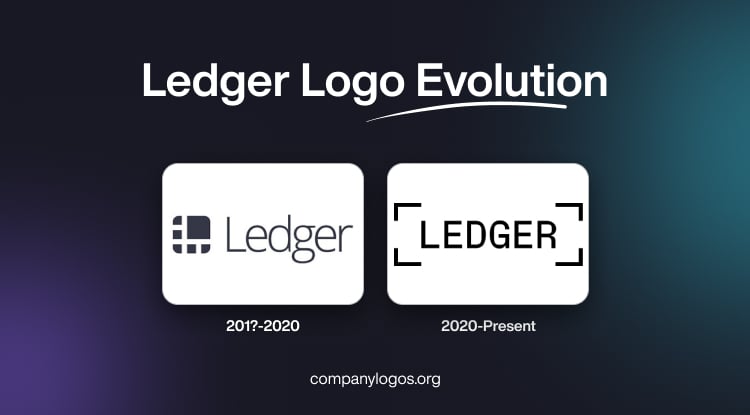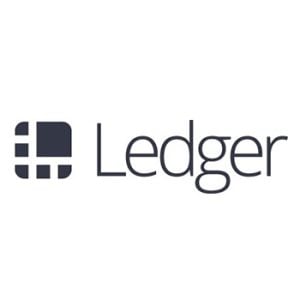
Ledger is a leading company specialising in cryptocurrency security and blockchain infrastructure solutions. Founded in 2014 and based in Paris, France, Ledger is best known for its hardware wallets, such as the Ledger Nano S and Ledger Nano X. These store private keys offline securely and protect digital assets from cyber threats. The company has become a trusted name among both retail users and institutions. Ledger aims to provide individuals and enterprises with the tools to safely access and interact with the digital economy. This aspect makes the company a cornerstone of the Web3 revolution.
The Ledger logo has undergone a few changes since the inception of the company. The logo iterations reflect the journey of the company, convey trust and security, and act as a gateway to Web3. The article delves into the evolution of the Ledger logo, among other details of the company.
The Genesis of the Ledger Logo (201? – 2020)
The original logo constituted an emblem to the left and a wordmark. The emblem looked like a modular icon, similar to a chip, to emphasise the company’s ties to blockchain. The modular emblem had thin vertical and horizontal lines in white crisscrossing small and large blocks in black. Designed in black, the wordmark to the right of the emblem was written in a title case using a thin and traditional sans-serif typeface.

(2020 – Present)
The current Ledger logo features the wordmark “LEDGER” in a bold uppercase and written using a geometric sans-serif typeface. It is placed between two disjointed brackets on either side to symbolise safety and enclosure, which is a subtle metaphor for protecting assets. The brackets and wordmark are shown in black against a white background.

The Elements of the Ledger Logo
Font
The Ledger logo uses a custom sans-serif font that appears geometric, simple, and professional. It communicates clarity, precision, and tech-forward thinking. The font also resembles fonts like Proxima Nova or Avenir, which are known for their clean, rounded features.
Colour
The primary colour of the Ledger logo is black or dark grey. The colour choice signifies seriousness, stability, and security, qualities that are critical to a brand specialising in cryptocurrency protection.
The History of Ledger
Ledger is a blockchain security company founded in Paris, France, in 2014 by a team of eight experts with backgrounds in embedded security, cryptocurrencies, and entrepreneurship. The founding team included Eric Larchevêque, Nicolas Bacca, and Joel Pons, who identified the critical need for secure cryptocurrency storage solutions in the emerging digital asset space.
Ledger’s initial focus was on creating a secure hardware device to protect private keys from cyberattacks. They thought of these devices as being isolated from internet-connected computers. Their first product, the Ledger Nano, was a compact USB-connected hardware wallet designed to safely manage cryptocurrency transactions by offering an air-gapped environment. This addressed vulnerabilities in software wallets and provided a stronger security model for managing digital assets.
The company quickly gained traction with the release of the Ledger Nano S in 2016, which became popular for its security and affordability. Ledger expanded its product lineup further with the Ledger Nano X in 2019. For this device, it introduced Bluetooth connectivity and enhanced mobile features to improve user convenience while maintaining high security standards.
Ledger grew rapidly and was supported by several funding rounds. For instance, it raised $7 million in Series A funding in 2017, $75 million in Series B in 2018, and over $380 million in Series C by 2021. This capital helped the company scale operations, expand its team and offices (in locations including Paris, Vierzon, London, Portland, and Singapore), and broaden support for a wider range of cryptocurrencies and digital assets.
Over the years, Ledger has focused on using secure element technology and its proprietary operating system (BOLOS) to protect digital assets. The company’s products are trusted globally, with millions of devices sold and used in over 180 countries.
Ledger has also moved beyond individual consumers by developing infrastructure for institutions such as banks, hedge funds, and high-net-worth individuals by offering enterprise-grade security solutions. The company continues to innovate in blockchain security and aims to secure broader applications of blockchain technology in digital identity and Web3 infrastructure.
Interesting Facts About Ledger
- Ledger is one of the world’s leading providers of hardware wallets. In other words, physical devices that securely store cryptocurrency private keys offline. Its products are widely used by individual investors, traders, and institutions alike.
- Ledger was founded in 2014 and is headquartered in Paris, France, with additional offices in Vierzon (France), New York, and Hong Kong.
- The Ledger Nano S and Ledger Nano X are among the most popular hardware wallets globally. They support over 5,500 cryptocurrencies and tokens.
- Ledger devices use a “Secure Element” (SE) chip, which is a tamper-resistant hardware component used in passports and credit cards. This chip ensures the highest level of data protection.
- Ledger developed Ledger Live, a desktop and mobile app that lets users manage crypto assets, stake coins, and connect with decentralised finance (DeFi) applications while keeping private keys offline.
- In 2020, Ledger suffered a data breach that leaked customer information like names and email addresses, though wallets and funds were never compromised. It raised concerns but also pushed the company to improve its data protection policies.
- Ledger encourages third-party development and open-source contributions. It provides a developer portal and SDK for building apps on Ledger devices.
- Ledger also serves institutions with Ledger Enterprise. It offers customised custody solutions and advanced governance tools for businesses managing large crypto holdings.
- As of 2023, Ledger has raised more than $500 million in funding from investors like Samsung, Cathay Innovation, Draper Associates, and 10T Holdings, which shows strong industry confidence.
- Ledger has expanded into Web3 and NFTs and offers support for NFT storage. It partners with artists and brands to ensure safe digital asset management.
Finally
The evolution of the Ledger logo shows the journey of the company from a security-focused hardware startup to a global Web3 platform. The logo iterations, especially the most recent rebrand, symbolise Ledger’s aspiration to secure and simplify digital asset management for a new generation of users.